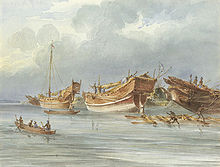Sitakunda Upazila
[6][7] The legends of the area state the sage Bhargava created a pond (kunda) for Sita to bathe in when her husband Lord Ramchandra visited during his exile in the forests.
[10] In 1886, shouldered celts manufactured from petrified wood were discovered, as reported by Indian archaeologist Rakhaldas Bandyopadhyay in his book Banglar Itihas, or History of Bengal, (volume I, 1914).
Rapid growth in the Bengali population since then resulted in an exodus of non-Bengali people from Sitakunda and its vicinity to the Chittagong Hill Tracts.
[27][28][29] On 15 February 1950, Hindu pilgrims form all over East Bengal, Tripura and Assam arriving for Maha Shivaratri were attacked by the Ansars and armed Muslim mobs and massacred at the Sitakunda railway station.
[35] It is bordered by Mirsharai to the north, Pahartali to the south, Fatickchhari, Hathazari and Panchlaish to the east, and the Sandwip Channel in the Bay of Bengal to the west.
[37] About 5 kilometres (3 mi) north of Sitakunda Town is the Labanakhya saltwater hot spring, which has been proposed as a source of geothermal energy.
[43] The intra-deltaic coastline is very close to the tectonic interface of the Indian and Burmese plates, as well as the active Andaman–Nicobar fault system, and is often capable of generating tsunamis.
The cyclone of 1990 smashed about 25% of a 2-kilometre (1 mi) sea-wall built using two-ton steel-reinforced concrete blocks, some of which were carried up to 100 metres (328 ft) inland.
[14] Along with Chittagong and Hathazari, in June 2007 Sitakunda was badly affected by mudslides caused by heavy rainfall combined with the recent practice of hill-cutting.
Both the gently dipping eastern and steeper western flanks of the anticline are truncated abruptly by the alluvial plain of the Feni River.
[45] After the earthquake of 2 April 1762, which caused a permanent submergence of 155.4 square kilometres (60.0 sq mi) of land near Chittagong and the death of 500 people in Dhaka, two volcanoes are said to have opened in the Sitakunda hills.
[58][59] During a seismic tremor on 7 November 2007, fire broke out at the Bakharabad Gas Systems Limited in the Faujderhat area of the upazila when a pipeline was fractured.
[81] Anwarul Kabir Talukder, the State Minister for Power, lost his job on 29 September 2006 after hundreds of demonstrators in Sitakunda blocked the Dhaka–Chittagong highway in protest at the lack of electricity; violence also erupted elsewhere in Bangladesh.
[87] Organized under the Bangladesh Ship Breakers Association, (BSBA),[28] these include companies within large local conglomerates that sought ISO certificates.
[89] The ship breaking industry is purportedly damaging the local ecology as well, taking a toll on the fish population and soil quality.
[96] There have also been allegations of large quantities of steel and non-ferrous items, such as bronze, aluminum, copper, and bronze-amalgam recovered from ship breaking being smuggled out of Bangladesh.
[36] Fishing has traditionally been an industry restricted to low caste Hindus belonging to the fisher class, although since the last decades of the 20th century an increasing number of Muslims have joined the sector.
[106] Operators of local brick kilns are engaged in illegal hill cutting, a practice that was responsible along with heavy rainfall for the 2007 Chittagong mudslide.
A workshop conducted by Asian Development Bank (ADB) estimated that improving the highway would increase Bangladesh's GDP by 1% and its foreign trade by 20%.
[77] The rail tracks were established as part of the Bengal Assam Railway in 1898, originally running from Chittagong to Badarpur, with branches to Silchar and Laksam.
[116] Bangladesh NGOs Network for Radio and Communication (BNNRC) has brought internet services to the upazila by establishing Rural Knowledge Centres (RKC).
[122] Knowing that the dance of destruction was about to annihilate the world, Vishnu cut the body of Sati to pieces with Sudarshana Chakram, his celestial weapon, thereby appeasing Shiva.
[8][125] Chandranath is within the jurisdiction of Gobardhan Math, which was founded, according to legends, by Padmacharya, a disciple of Shankaracharya and founder of Vana and Aranya sects of the Dashanami Sampradaya.
[8][125] These temples have been subject to repeated attack and violation by Muslims,[126] and Bangladesh Hindu Bouddha Christian Oikya Parishad has asked for the pilgrims to be protected.
[128] The topmost level consists of Garjan (Dipterocarpus alatus), Telsur (Hopea odorata), Chapalish (Artocarpus chaplasha), Chundul (Tetrameles nudiflora) and Koroi or the Moluccan albizia (Falcataria moluccana).
The lower level consists of species of Jarul (Lagerstroemia speciosa), Toon (Toona ciliata), Jam (Syzygium cumini), Jalpai (Elaeocarpus robustus) and Glochidion.
[128] Savannah formations are found in the open, along the banks of rivers and swamps with common tall grasses like Kans (Saccharum spontaneum), Shon (Imperata cylindrica and I. arundincca) and Bena (Vetiveria zizanoides).
[100] They include Bhoal (Raiamas bola), Lakkhya (Eleutheronema tetradactylum), Chapila (Gudusia chapra), Datina (Acanthopagrus latus), Rupchanda (Pampus argenteus), Pungash (Pangasius pangasius), Chhuri (Trichiurus lepturus), Ilsha Chandana (Tenualosa toli), Hilsha (Tenualosa ilisha), Faishya (Anchoviella commersonii), Maittya (Scomberomorus commerson), Gnhora (Labeo gonius), Kata (Nemapteryx nenga), Chewa (Taenioides cirratus), Sundari bele (Glossogobius giuris), Bnata (Liza parsia), Koral (Etroplus suratensis) and Kawoon (Anabas testudineus), as well as crustaceans like tiger shrimps.
[131] The eco-park was established to facilitate biodiversity conservation, natural regeneration, new plantations and infrastructure development, as well as to promote nature-based tourism to generate income.
[144] He was abducted and tortured by unidentified men allegedly on charges of protesting against the harassment of Mahmudul Haq, editor of local magazine Upanagar.













